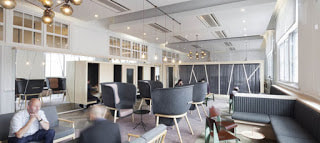 Most readers of this blog have private offices with doors that can close when we want to work without noise or interruptions. Colleagues understand the difference between a closed door and one that is slightly or fully opened, and they adjust accordingly. The same doors also give privacy, which is highly valued. Some readers of this blog also work for an organization that has a policy of flexible work time, and I am willing to bet that they value this flexibility. Many employees, in many organizations, work in cubicles, which is an entirely different situation. As a research paper by Leroy Gonsalves in Administrative Science Quarterly shows, flexible work time is often much less flexible than people think. As he discovered, the cubicles are one reason for the inflexibility. What is the connection between cubicles and inflexible flexible work time? Visibility. Flexible work time means that people can arrive and depart from work at times they select, provided they spend enough time working. But workers in cubicles are seen by others, so the early riser can’t come too early because it means leaving before the others, and the late riser can’t come too late because that means arriving after the others. When people gather, there can be informal norms. Norms can become toxic if they are connected to ideas of effort and productivity, and norms guide people’s visible behavior. Many small behaviors demonstrate visibility and make the work time inflexible. The morning greeting is an acknowledgment of arrival, less formal than stamping a time card but nearly as controlling. Walking past an empty desk in a cubicle raises the question of where the occupant is, and also serves as a reminder of the question others will consider when walking past one’s own empty cubicle. The effect is to remind everyone of the need to arrive exactly at the normative time. How did Gonsalves discover this source of inflexible flexible work time? He studied an organization that reorganized its office to save space, eliminating cubicles assigned to specific people and replacing them with dynamic workspaces. In the new office, work stations were classified by activity, and employees would move around during the day depending on the type of work they did. These were professional workers who carried a laptop around that contained everything they needed for their work. The big surprise was that the new, smaller, and flexible-use office also triggered much greater use of flexible time. The workers quickly realized that the visibility was gone. An empty desk said nothing because it was not assigned to a person. Greeting someone in the morning, or not greeting them, also said nothing because it was unclear what part of the office someone would be in and what time of the day that person would have started work. With the visibility gone, workers immediately started using the flexible work time policy the way it was intended. Flexible work time lets workers adapt to their circadian rhythm, improve their commute, and adapt to temporary work requirements. Arrive late if you are a late riser, avoid the worst morning rush hour, and work longer hours when needed and shorter hours to even out the worktime. All of these are possible as long as the visibility does not impose a norm that creates an inflexible flexible work time. Organizational theory is often about unintended consequences. An employer saves office rental fees through using cubicles and unintendedly ruins its flexible work time policy that is supposed to improve the workers’ lives and the work. An employer saves even more office rental fees by replacing cubicles with flexible work spaces and inadvertently converting its workers from surface ships to submarines, who take full advantage of their stealth. I am sure the submarine workers are happier with their flexible work time, and maybe they are also more productive, so this was a good unintended consequence. Gonsalves, L. 2020. From Face Time to Flex Time: The Role of Physical Space in Worker Temporal Flexibility. Administrative Science Quarterly, forthcoming. Comments are closed.
|
Blog's objectiveThis blog is devoted to discussions of how events in the news illustrate organizational research and can be explained by organizational theory. It is only updated when I have time to spare. Archives
May 2024
Categories |
 RSS Feed
RSS Feed